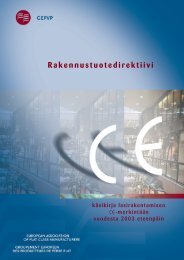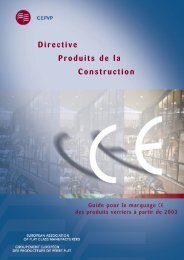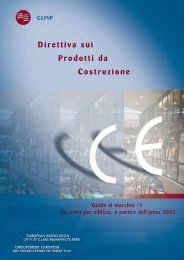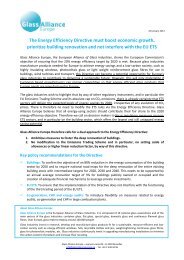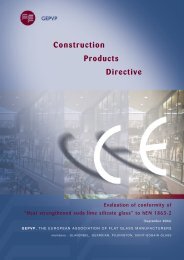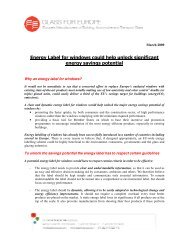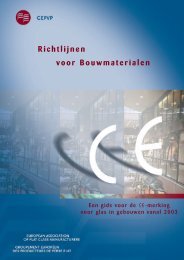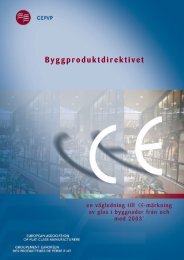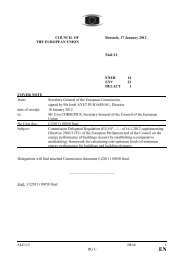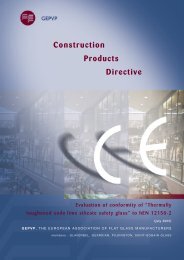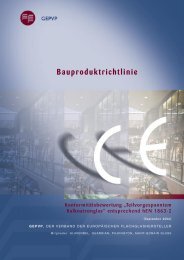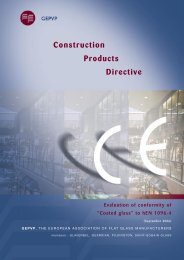glass for europe statement on food contact materials
glass for europe statement on food contact materials
glass for europe statement on food contact materials
You also want an ePaper? Increase the reach of your titles
YUMPU automatically turns print PDFs into web optimized ePapers that Google loves.
February 2013<br />
GLASS FOR EUROPE STATEMENT ON FOOD CONTACT MATERIALS<br />
The European Commissi<strong>on</strong> is currently reviewing the existing regulatory framework <strong>on</strong> <strong>food</strong> c<strong>on</strong>tact <strong>materials</strong>,<br />
in particular Directive 84/500/EEC <str<strong>on</strong>g>for</str<strong>on</strong>g> ceramic articles. Am<strong>on</strong>g the discussed features of this revisi<strong>on</strong> are:<br />
- the extensi<strong>on</strong> of the Directive’s scope to <str<strong>on</strong>g>glass</str<strong>on</strong>g> <strong>materials</strong> and articles,<br />
- a significant reducti<strong>on</strong> of the limit values <str<strong>on</strong>g>for</str<strong>on</strong>g> the migrati<strong>on</strong> of lead (Pb, reducti<strong>on</strong> by a factor of 400)<br />
and cadmium (Cd, reducti<strong>on</strong> by a factor of 60) and,<br />
- at a subsequent stage, the inclusi<strong>on</strong> of limit values <str<strong>on</strong>g>for</str<strong>on</strong>g> other metals and the definiti<strong>on</strong> of a new<br />
c<strong>on</strong>cept of overall migrati<strong>on</strong>.<br />
Glass products currently fall under the Framework Regulati<strong>on</strong> (EC) 1935/2004 <strong>on</strong> <strong>materials</strong> and articles<br />
intended to come into c<strong>on</strong>tact with <strong>food</strong>. They are not covered by specific measures like those established <str<strong>on</strong>g>for</str<strong>on</strong>g><br />
ceramic articles under the Directive 84/500/EEC. Nevertheless, <str<strong>on</strong>g>glass</str<strong>on</strong>g> manufacturers follow Directive<br />
84/500/EEC <strong>on</strong> a voluntary basis.<br />
Glass <str<strong>on</strong>g>for</str<strong>on</strong>g> Europe understands that the proposed revisi<strong>on</strong> and new limit values are driven by the European<br />
authorities’ intenti<strong>on</strong> to put in place the most stringent regulatory framework with a view to eliminating any<br />
potential health risk.<br />
Since the European Commissi<strong>on</strong> is c<strong>on</strong>sidering a review of Directive 84/500/EEC and its possible extensi<strong>on</strong> to<br />
<str<strong>on</strong>g>glass</str<strong>on</strong>g> products and articles, Glass <str<strong>on</strong>g>for</str<strong>on</strong>g> Europe would like to highlight some of the specificities of soda-lime<br />
silicate flat <str<strong>on</strong>g>glass</str<strong>on</strong>g> products. Am<strong>on</strong>g these specificities is the fact that heavy metals such as cadmium and lead<br />
are never intenti<strong>on</strong>ally added in soda-lime silicate flat <str<strong>on</strong>g>glass</str<strong>on</strong>g>.<br />
In light of these specificities, undetectable migrati<strong>on</strong> dem<strong>on</strong>strated using currently available techniques<br />
and the disproporti<strong>on</strong>ate nature of the measure <str<strong>on</strong>g>for</str<strong>on</strong>g> a sector serving principally the c<strong>on</strong>structi<strong>on</strong> and<br />
automotive industries, Glass <str<strong>on</strong>g>for</str<strong>on</strong>g> Europe believes that:<br />
1. clear soda-lime silicate flat <str<strong>on</strong>g>glass</str<strong>on</strong>g> should be exempted from systematic testing obligati<strong>on</strong>s 1 .<br />
2. coloured soda-lime silicate flat <str<strong>on</strong>g>glass</str<strong>on</strong>g> should also be exempted when no lead or cadmium<br />
compounds are intenti<strong>on</strong>ally added in the raw <strong>materials</strong>.<br />
1 This would be c<strong>on</strong>sistent with a UK study commissi<strong>on</strong>ed by the UK Food Standards Agency <strong>on</strong> the elemental migrati<strong>on</strong> from <str<strong>on</strong>g>glass</str<strong>on</strong>g> items in c<strong>on</strong>tact<br />
with <strong>food</strong>stuffs. The study was c<strong>on</strong>ducted by Dr Adam Kelsall and Nicola Broadhurst of Glass Technology Services in Sheffield in 2003. Soda lime silica<br />
flat ware was not regarded as a “<str<strong>on</strong>g>glass</str<strong>on</strong>g> type of interest” (based <strong>on</strong> its compositi<strong>on</strong> and propositi<strong>on</strong> of use) and there<str<strong>on</strong>g>for</str<strong>on</strong>g>e not included in the range of<br />
<str<strong>on</strong>g>glass</str<strong>on</strong>g> compositi<strong>on</strong>s in comm<strong>on</strong> use <str<strong>on</strong>g>for</str<strong>on</strong>g> <strong>food</strong> c<strong>on</strong>tact purposes analysed in the study. http://www.<strong>food</strong>base.org.uk/results.php?f_report_id=316
Use of flat <str<strong>on</strong>g>glass</str<strong>on</strong>g> <str<strong>on</strong>g>for</str<strong>on</strong>g> <strong>food</strong> applicati<strong>on</strong>s is really very limited and rare: flat <str<strong>on</strong>g>glass</str<strong>on</strong>g> is mostly used in<br />
buildings, automotive and solar energy modules<br />
More than 99% of flat <str<strong>on</strong>g>glass</str<strong>on</strong>g> producti<strong>on</strong> is used <str<strong>on</strong>g>for</str<strong>on</strong>g> windows, facades, automotive <str<strong>on</strong>g>glass</str<strong>on</strong>g> and solar energy<br />
modules. Only a very small fracti<strong>on</strong> of flat <str<strong>on</strong>g>glass</str<strong>on</strong>g> producti<strong>on</strong> (much lower than 1% taking into account all other<br />
applicati<strong>on</strong>s) is used in products intended <str<strong>on</strong>g>for</str<strong>on</strong>g> <strong>food</strong> c<strong>on</strong>tact. This limited number of articles includes cutting<br />
boards, decorative serving plates, tables and counter tops and fridge shelves.<br />
Although quantities of flat <str<strong>on</strong>g>glass</str<strong>on</strong>g> products that may have <strong>food</strong> c<strong>on</strong>tact applicati<strong>on</strong>s are almost negligible,<br />
dem<strong>on</strong>strati<strong>on</strong> of compliance with new limit values would be required <str<strong>on</strong>g>for</str<strong>on</strong>g> all flat <str<strong>on</strong>g>glass</str<strong>on</strong>g> producti<strong>on</strong> (over 9<br />
milli<strong>on</strong> t<strong>on</strong>nes in the EU), as the products’ final destinati<strong>on</strong> and usage are not known to the flat <str<strong>on</strong>g>glass</str<strong>on</strong>g><br />
producer at the time of producti<strong>on</strong>.<br />
Absence of health hazard<br />
Current tests per<str<strong>on</strong>g>for</str<strong>on</strong>g>med by flat <str<strong>on</strong>g>glass</str<strong>on</strong>g> companies to dem<strong>on</strong>strate compliance with the existing migrati<strong>on</strong> limits<br />
have c<strong>on</strong>sistently c<strong>on</strong>firmed, with large c<strong>on</strong>fidence, compliance with the limits. Indeed all the results are<br />
below the quantificati<strong>on</strong> limits of the analytical equipment comm<strong>on</strong>ly used in laboratories.<br />
In fact, leaching testing per<str<strong>on</strong>g>for</str<strong>on</strong>g>med <strong>on</strong> flat <str<strong>on</strong>g>glass</str<strong>on</strong>g> has c<strong>on</strong>sistently showed that <str<strong>on</strong>g>for</str<strong>on</strong>g> lead and cadmium, flat <str<strong>on</strong>g>glass</str<strong>on</strong>g><br />
products are at least 500 times lower than the limits set by Directive 84/500/EEC and ISO 6486-2:1999,<br />
which applies to ceramic and <str<strong>on</strong>g>glass</str<strong>on</strong>g> articles intended to come into c<strong>on</strong>tact with <strong>food</strong>stuffs.<br />
Testing c<strong>on</strong>diti<strong>on</strong>s not adapted to the reality of <strong>food</strong> c<strong>on</strong>tact of flat <str<strong>on</strong>g>glass</str<strong>on</strong>g> products<br />
Unlike other articles potentially targeted by the Directive, flat <str<strong>on</strong>g>glass</str<strong>on</strong>g> products that are used <str<strong>on</strong>g>for</str<strong>on</strong>g> <strong>food</strong> c<strong>on</strong>tact<br />
purposes are usually intended to have short-c<strong>on</strong>tact times and c<strong>on</strong>tact with <strong>food</strong> in the solid state <strong>on</strong>ly. The<br />
prescribed testing c<strong>on</strong>diti<strong>on</strong>s (24h c<strong>on</strong>tact at 22°C in 4% acetic acid) are not representative of a solid<br />
exchange 2 . Such test c<strong>on</strong>diti<strong>on</strong>s would there<str<strong>on</strong>g>for</str<strong>on</strong>g>e lead to a major overestimati<strong>on</strong> of real migrati<strong>on</strong>, and<br />
c<strong>on</strong>sequently c<strong>on</strong>sumer exposure.<br />
A disproporti<strong>on</strong>ate burden <strong>on</strong> producers <str<strong>on</strong>g>for</str<strong>on</strong>g> no public health benefit<br />
Rec<strong>on</strong>firming compliance with the newly proposed limits cannot be per<str<strong>on</strong>g>for</str<strong>on</strong>g>med internally by companies since<br />
the proposed new limit values <str<strong>on</strong>g>for</str<strong>on</strong>g> lead and cadmium migrati<strong>on</strong> requires specific testing c<strong>on</strong>diti<strong>on</strong>s including<br />
the use of ultra-pure reagents, clean rooms and the most advanced equipment in terms of accuracy. It would<br />
there<str<strong>on</strong>g>for</str<strong>on</strong>g>e require testing to be d<strong>on</strong>e by specialised external laboratories that have the appropriate equipment<br />
and expertise to per<str<strong>on</strong>g>for</str<strong>on</strong>g>m this testing.<br />
Even if a combinati<strong>on</strong> of laboratory type tests and proxy tests were allowed, this would still be<br />
disproporti<strong>on</strong>ate c<strong>on</strong>sidering that over 99% of flat <str<strong>on</strong>g>glass</str<strong>on</strong>g> products will never be used <str<strong>on</strong>g>for</str<strong>on</strong>g> <strong>food</strong> c<strong>on</strong>tact<br />
applicati<strong>on</strong>s. In this c<strong>on</strong>text, imposing the testing of all flat <str<strong>on</strong>g>glass</str<strong>on</strong>g> produced in Europe would put a major<br />
2 For instance, tests provide results per liter and c<strong>on</strong>versi<strong>on</strong> factors have to be used <str<strong>on</strong>g>for</str<strong>on</strong>g> flat ware. The c<strong>on</strong>versi<strong>on</strong> factor is based <strong>on</strong> a factor of 6 from<br />
liters to square decimeters (c<strong>on</strong>sidering the sum of the areas of the 6 faces of a cube of 1 liter), which implies a c<strong>on</strong>tact with all faces and the entire<br />
area of each of the 6 faces, which simply cannot physically happen while using products made of flat <str<strong>on</strong>g>glass</str<strong>on</strong>g>.<br />
Glass <str<strong>on</strong>g>for</str<strong>on</strong>g> Europe <str<strong>on</strong>g>statement</str<strong>on</strong>g> <strong>on</strong> Food C<strong>on</strong>tact Materials – February 2013 Page | 2
urden <strong>on</strong> manufacturers, whereas all scientific evidence shows that soda-lime silicate flat <str<strong>on</strong>g>glass</str<strong>on</strong>g> products<br />
do not pose migrati<strong>on</strong> problems.<br />
Finally, it must be kept in mind that flat <str<strong>on</strong>g>glass</str<strong>on</strong>g> manufacturers do not put <strong>on</strong> the market the ‘final articles’ but<br />
<strong>on</strong>ly supply the <str<strong>on</strong>g>glass</str<strong>on</strong>g> to downstream processors that are specialised small and medium-size companies<br />
(SMEs). These SMEs may face major difficulties in dem<strong>on</strong>strating compliance <str<strong>on</strong>g>for</str<strong>on</strong>g> their final flatware<br />
products. Indeed they would be <str<strong>on</strong>g>for</str<strong>on</strong>g>ced to dem<strong>on</strong>strate compliance <str<strong>on</strong>g>for</str<strong>on</strong>g> each c<strong>on</strong>signment of flat <str<strong>on</strong>g>glass</str<strong>on</strong>g>.<br />
***<br />
In view of the inert properties of <str<strong>on</strong>g>glass</str<strong>on</strong>g>, the compositi<strong>on</strong> of soda-lime silicate flat <str<strong>on</strong>g>glass</str<strong>on</strong>g> and very low<br />
migrati<strong>on</strong> dem<strong>on</strong>strated using currently available techniques, <str<strong>on</strong>g>glass</str<strong>on</strong>g> manufacturers firmly believe that:<br />
1. clear soda lime silicate flat <str<strong>on</strong>g>glass</str<strong>on</strong>g> intended to be in c<strong>on</strong>tact with <strong>food</strong> should be exempted from<br />
systematic testing obligati<strong>on</strong>s.<br />
2. The same exempti<strong>on</strong> should apply to coloured soda-lime silicate flat <str<strong>on</strong>g>glass</str<strong>on</strong>g> when no lead or<br />
cadmium are intenti<strong>on</strong>ally introduced in the raw <strong>materials</strong>.<br />
***<br />
About Glass <str<strong>on</strong>g>for</str<strong>on</strong>g> Europe<br />
Glass <str<strong>on</strong>g>for</str<strong>on</strong>g> Europe is the trade associati<strong>on</strong> <str<strong>on</strong>g>for</str<strong>on</strong>g> Europe’s manufacturers of flat <str<strong>on</strong>g>glass</str<strong>on</strong>g>. Flat <str<strong>on</strong>g>glass</str<strong>on</strong>g> is the material that goes into a<br />
variety of end-products and primarily in windows and façades <str<strong>on</strong>g>for</str<strong>on</strong>g> buildings, windscreens and windows <str<strong>on</strong>g>for</str<strong>on</strong>g> automotive<br />
and transport as well as <str<strong>on</strong>g>glass</str<strong>on</strong>g> covers, c<strong>on</strong>nectors and mirrors <str<strong>on</strong>g>for</str<strong>on</strong>g> solar-energy equipments. Although in nearly<br />
c<strong>on</strong>fidential quantities, flat <str<strong>on</strong>g>glass</str<strong>on</strong>g> is also used <str<strong>on</strong>g>for</str<strong>on</strong>g> many other applicati<strong>on</strong>s such as furniture, electr<strong>on</strong>ics, appliances, etc.<br />
Glass <str<strong>on</strong>g>for</str<strong>on</strong>g> Europe has four members: AGC Glass Europe, NSG-Group, Saint-Gobain Glass and Sisecam-Trakya Cam and<br />
works in associati<strong>on</strong> with Guardian. Altogether, these five companies represent 90% of Europe’s flat <str<strong>on</strong>g>glass</str<strong>on</strong>g> producti<strong>on</strong>.<br />
Glass <str<strong>on</strong>g>for</str<strong>on</strong>g> Europe firmly believes that state-of-the-art <str<strong>on</strong>g>glass</str<strong>on</strong>g>, such as Low-E insulating <str<strong>on</strong>g>glass</str<strong>on</strong>g>, Solar-C<strong>on</strong>trol <str<strong>on</strong>g>glass</str<strong>on</strong>g> and Solar-<br />
Energy <str<strong>on</strong>g>glass</str<strong>on</strong>g> can play a vital role in achieving the EU’s energy saving targets and promotes ambitious mechanisms to<br />
support the market uptake of energy-efficient <str<strong>on</strong>g>glass</str<strong>on</strong>g> technologies.<br />
Glass <str<strong>on</strong>g>for</str<strong>on</strong>g> Europe <str<strong>on</strong>g>statement</str<strong>on</strong>g> <strong>on</strong> Food C<strong>on</strong>tact Materials – February 2013 Page | 3



